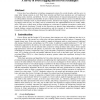Free Online Productivity Tools
i2Speak
i2Symbol
i2OCR
iTex2Img
iWeb2Print
iWeb2Shot
i2Type
iPdf2Split
iPdf2Merge
i2Bopomofo
i2Arabic
i2Style
i2Image
i2PDF
iLatex2Rtf
Sci2ools
TODS
2012
2012
A survey of B-tree logging and recovery techniques
B-trees have been ubiquitous in database management systems for several decades, and they serve in many other storage systems as well. Their basic structure and their basic operations are well understood including search, insertion, and deletion. However, implementation of transactional guarantees such as allor-nothing failure atomicity and durability in spite of media and system failures seems to be difficult. Highperformance techniques such as pseudo-deleted records, allocation-only logging, and transaction processing during crash recovery are widely used in commercial B-tree implementations but not widely understood. This survey collects many of these techniques as a reference for students, researchers, system architects, and software developers. Central in this discussion are physical data independence, separation of logical database contents and physical representation, and the concepts of user transactions and system transactions. Many of the techniques discussed are applicable ...
Database Management Systems | Physical Data Independence | Programming Languages | System Architects | TODS 2012 |
| Added | 27 Sep 2012 |
| Updated | 27 Sep 2012 |
| Type | Journal |
| Year | 2012 |
| Where | TODS |
| Authors | Goetz Graefe |
Comments (0)

